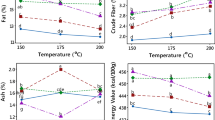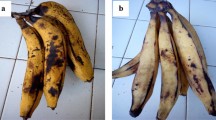Abstract
Chemical composition and functional properties of flour blends containing various levels of maize (100–0%) and bambara groundnut (0–100%) were studied. The resultant blends were high in protein, carbohydrate and caloric value. The blends contained fair amounts of Ca, P and K but were low in Na and Fe. The oil and water absorption capacities of the blends were fairly high ranging from 3.65 to 3.81 g oil/g sample and 3.40 to 3.80 g water/g sample, respectively. The gelation concentration of the blends tended to increase with increase in amount of maize flour in the blend. On the other hand, increasing the level of maize flour in the blends considerably reduced the foaming capacities of the blends. The flour blends had good emulsifying properties. Cookies prepared from the blends contained proteins ranging from 10.9 to 21.65% The cookies had good spread and were significantly lighter than the wheat control cookies. Sensory evaluation scores for cookies showed that the best level of combination was 75% maize flour and 25% bambara groundnut flour.
Similar content being viewed by others
References
Akpapunam MA (1984) Characteristics of moin-moin flour prepared from cowpea/maize blends. Nigerian Food 2(2): 207–208.
Bressani R, Valiente AT, Tejada CE (1962) All-vegetable protein mixtures for human feeding, VI: The value of combinations of lime-treated corn and cooked black beans. J Food Sci 27: 394–401.
Bressani R, Elias LG (1969) Studies on the use of Opaque-2-corn in vegetable protein-rich foods. J Agr Food Chem 17: 659–663.
Lartey BL (1967) The production of bamcorn, a maize-bambara groundnut product. Ghana J Agr Sci 9(2): 139–142.
Akinyele IO, Fasaye OA (1988) Nutrient quality of corn and sorghum supplementation with cowpea (Vigna unguiculata) in the traditional manufacture of Ogi. J Food Sci 53(6): 1750–1755.
Oyenuga VA (1968) Nigeria's food and feeding stuff. Ibadan (Nigeria): Ibadan University Press.
Poulter NH (1981) Properties of some protein fractions from bambara groundnut (Voandzeia subterranea (L.) Thouars). J Sci Food Agr 32: 44–50.
Duke JA (1983) Handbook of legumes of world economic importance. New York: Plenum Press.
Linnemann AR (1988) Cultivation of bambara groundnut (Vigna subterranea (L.) Verdc.) in Nigeria. Tropical Crop Communication No. 15. Wageningen Agricultural University, Department of Tropical Crop Science.
UNECA (1985) Technical compendium on composite flours. Addis Ababa (Ethiopia): United Nations Economic Commission For Africa.
Kellor RL (1974) Full-fat soy flour. Proceedings World soy protein conference, Munich, 11–14 November 1973). J Am Oil Chem Soc, Special issue 51 (1): 77A-80A.
Kinsella JE, Damodaran S, German B (1985) Physicochemical and functional properties of oil seed proteins with emphasis on soy protein. In: Altschul AM, Wilcke HL, eds. New protein foods, Vol 5. New York: Academic Press, p 107.
AOAC (1984) Official Methods of Analysis, 14th ed. Washington, DC: Association of Official Agricultural Chemists.
Pearson D (1976) The chemical analysis of foods, 7th ed. Edinburgh/London: Churchill Livingstone, p 20.
Okezie BO, Bello AB (1988) Physicochemical and functional properties of winged bean flour and isolate compared with soy isolate. J Food Sci 53: 450–454.
Sathe SK, Salunkhe DK (1981) Functional properties of the Great Northern bean (Phasceolus vulgaris L.) protein: Emulsion, foaming, viscosity, and gelation properties. J Food Sci 46: 71–74.
Nishibori S, Kawakishi S (1990) Effects of dough materials on flavour formation in baked cookies. J Food Sci 55(2): 409–412.
Steel RGD, Torric JH (1960) Principles and production of statistics. New York: McGraw-Hill.
Linnemann AR (1987) Bambara groundnut (Vigna subterranea) (L.) Verdc.): A review article. Tropical Agr 12(7): 9–25.
FAO (1970) Amino acid contents of foods. Rome: Food and Agricultural Organisation.
Abbeh BW, Ibeh GO (1987) Functional properties of raw and heat processed brown bean (Canavalis rosea (SW)) flour. J Food Sci 52(2): 406–408.
Shanmugasundaram T, Venkataraman LV (1989) Functional properties of defatted and detoxified madhuca (Madhuca butyraceae) seed flour. J Food Sci 54 (2): 351–353.
Author information
Authors and Affiliations
Rights and permissions
About this article
Cite this article
Akpapunam, M.A., Darbe, J.W. Chemical composition and functional properties of blends of maize and bambara groundnut flours for cookie production. Plant Food Hum Nutr 46, 147–155 (1994). https://doi.org/10.1007/BF01088767
Received:
Accepted:
Issue Date:
DOI: https://doi.org/10.1007/BF01088767




